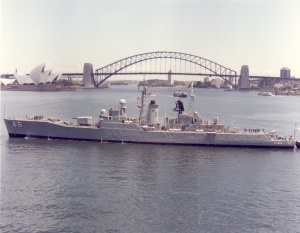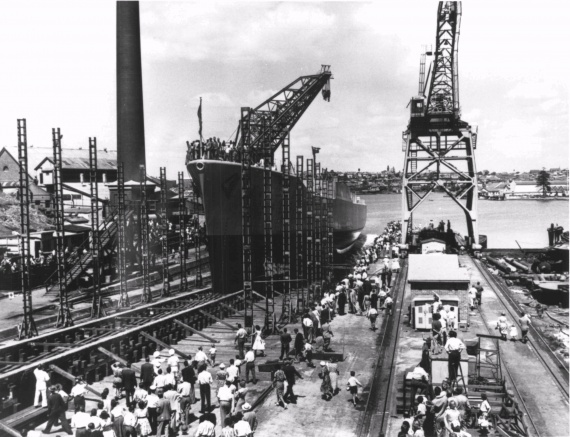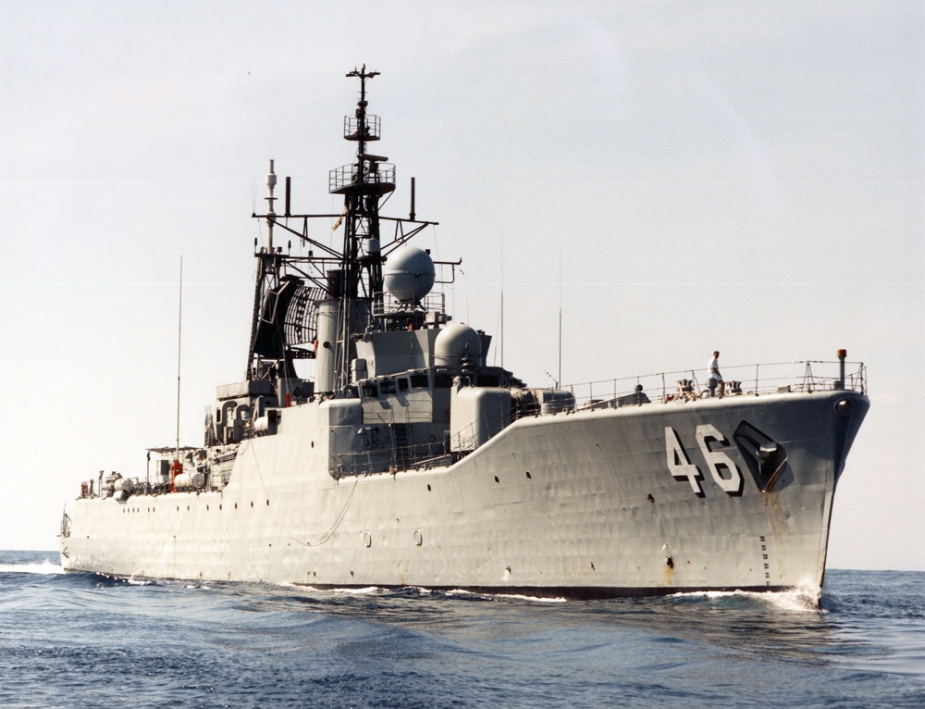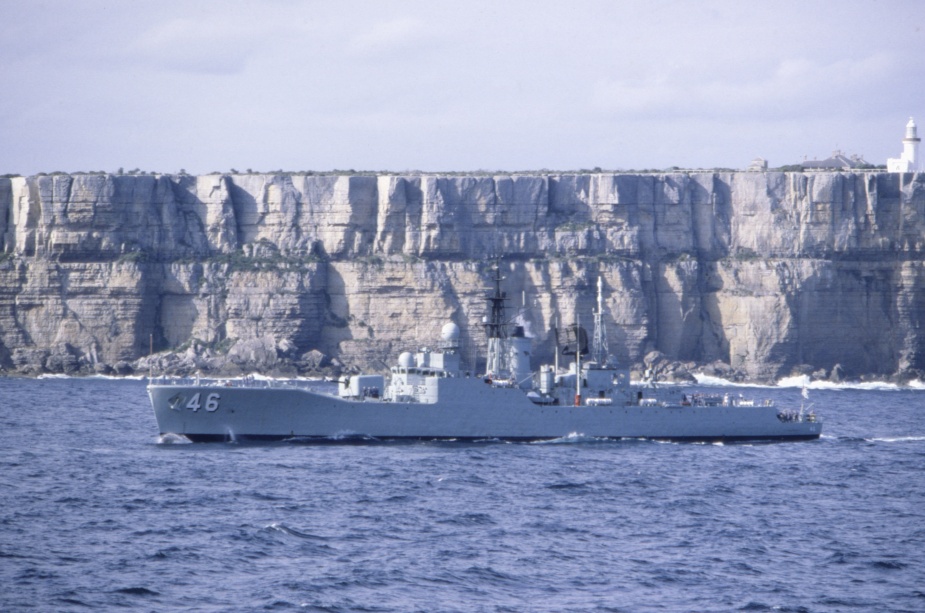HMAS Parramatta (III)
| Class |
River Class |
|---|---|
| Type |
Destroyer |
| Pennant |
DE46 |
| Builder |
Cockatoo Docks and Engineering Co Ltd, Sydney |
| Laid Down |
3 January 1957 |
| Launched |
31 January 1959 |
| Launched by |
Lady Dowling, wife of the First Naval Member and Chief of Naval Staff |
| Commissioned |
4 July 1961 |
| Decommissioned |
11 January 1991 |
| Dimensions & Displacement | |
| Displacement | 2700 tons |
| Length | 370 feet |
| Beam | 41 feet |
| Draught | 15 feet |
| Performance | |
| Speed | 30 knots |
| Complement | |
| Crew | 250 |
| Propulsion | |
| Machinery | Babcock & Wilcox geared turbines |
| Horsepower | 30,000 |
| Armament | |
| Missiles |
|
| Guns | 2 x 4.5-inch guns |
| Other Armament | Triple barrelled anti-submarine mortar |
| Awards | |
| Inherited Battle Honours | |
| Battle Honours | MALAYSIA 1964-66 |
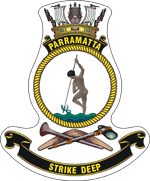
HMAS Parramatta was laid down at Cockatoo Island Dockyard, Sydney on 3 January 1957. She was launched on 31 January 1959 by Lady Dowling, wife of Vice Admiral Sir Roy Dowling, RAN the then Chief of Naval Staff.
On 15 June 1961, while still in the hands of the builders undergoing sea trials and wearing the Red Ensign, Parramatta took part, with commissioned units of the fleet, in a ceremonial entry into Port Jackson to mark the 50th anniversary of the RAN.
HMAS Parramatta commissioned at Sydney on 4 July 1961 under the command of Commander Guy Griffiths, DSC, RAN. She was the first of six new River Class destroyer escorts built for the RAN.
On 20 April 1962 Parramatta joined her sister ship Yarra deploying to the Far East where the two ships relieved HMA Ships Quickmatch and Vampire in the Britsh Commonwealth Strategic Reserve. During that deployment Parramatta's crew took part in the SEATO exercise SEA DEVIL before visiting Japan in company with other RAN vessels.
In August she and Yarra searched unsuccessfully for the British tug Kowloon Docks which was reportedly in distress in a typhoon in the South China Sea. Departing Hong Kong in September the two ships visited Port Swettenham and Singapore before steaming for Sydney, where they arrived on 10 October 1962 having been relieved of their Far East Strategic Reserve (FESR) duties.
In January 1963 Parramatta succeeded HMAS Queenborough as the leader of the 1st Frigate Squadron. The formal transfer took place at Sydney when the senior officer of the squadron, Captain B.S. Murray, RAN, assumed command. During February and March Parramattta, Anzac and Yarra undertook escort duty for HM Royal Yacht Britannia during the visit to Australia of Queen Elizabeth II and the Duke of Edinburgh.
On 17 March 1963 Parramatta deployed as part of a task group comprising the aircraft carrier HMAS Melbourne (II), Yarra (III) and Supply for a two month 'up top' tour of duty in S.E. Asia. There the task group took part in Exercise SEA SERPENT in May, after which Parramatta returned to Sydney. Later, in July, she steamed to Queensland waters taking part in fleet exercises in the Hervey Bay area. Later that year Captain J.J. Scrivener, RAN relieved Captain Murray in command.
Following a brief refit at Garden Island Dockyard in Sydney, Parramatta began the new year working up in company with Yarra before again deploying for the Far East on 28 January 1964. During their six month tour of duty with the FESR, the two ships took part in the large-scale exercises JET and LITGAS before returning home in mid-July. Later in the year Parramatta was equipped with the Seacat guided-missile system. Early in 1965 she carried out her first successful firing of the new weapon in waters off the NSW coast before again deploying for the Far East.
Following participation in Exercise SEAHORSE Parramatta paid a goodwill visit to Bangkok, after which she escorted HMAS Sydney (III) on the final leg of her first heavy troop-lift voyage to Vietnam. The ship also participated in anti-Indonesian infiltration patrols off Malaysian Borneo, before returning to Sydney in company with Yarra on 3 September 1965.
In February 1966 Parramatta was selected to perform the role of flagship at the Hobart Regatta in Tasmania. There her crew was treated to the famous hospitality of the Hobart community. On her return to Sydney, Commander R.H. Perry, RAN, who has assumed command of the ship in November 1964, relinquished command to Commander J.A. Mathew, RAN.
March 1966 saw the ship enter a three month long refit at Williamstown Naval Dockyard, Victoria, after which she rejoined the fleet on 24 June. In early July she again deployed for the Far East and in September she was employed conducting patrols in waters off Borneo. During October and November she exercised with ships of the Royal Navy, the United States Navy and RAN in waters off the Philippines before visiting Japan for Rest and Recreation (R & R). In November while transitting the Malacca Strait Parramatta damaged her propellers following a grounding. This necessitated repairs being carried out in Singapore and she subsequently returned to Sydney, in company with HMAS Stuart, in January 1967.
Parramatta deployed to the Far East for the sixth time in 1967, and, on 5 March 1968, then under Commander F.R. Woods, RAN, she steamed on her seventh tour in company with HMAS Vendetta. (II). By then the ship had become a familiar sight in S.E. Asian waters and Singapore her home away from home.
In October 1968 the ship was sorely in need of maintenance and on her return to Australia she was again placed in refit at Williamstown at which time Commander P.M. Rees, RAN, assumed command.
In February 1969 Parramatta again took part in the Hobart Regatta, renewing old acquaintences and making new friends in the Tasmanian capital. Later, in May, she departed Sydney with HMA Ships Melbourne and Supply en route for SEATO exercises in the Far East. She returned to Sydney later that year.
1970 saw the ship involved in a minor accident when on 28 February, while going astern having refuelled at Chowder Bay, Sydney, she collided with the Manly ferry Bellubera. Both vessels sustained minor damage but Parramatta's bow was holed necessitating repairs to be carried out at Garden Island Dockyard. By April, Parramatta was again on her way 'Up Top' joining Stuart in May and participating, with other Commonwealth ships, in the large-scale exercise BERSATU PADU off the coast of Malaysia. On 15 October the families of Parramatta's crew welcomed the ship back to Sydney after an absence of six months with the FESR. Shortly afterwards she again entered Williamstown Naval Dockard for a prolonged refit.
On 10 March 1971, by then under the command of Commander PGN Kennedy, RAN, Parramatta sailed in company with HMAS Duchess for yet another tour of duty with the FESR. She again visited Japan before being relieved by HMAS Swan (III) and returning to Sydney on 20 October.
The RAN's destroyer escorts (DE) had by that time proven themselves very capable ships in both the escort and patrol duties roles. Australia's committment to the FESR was largely shouldered by the DEs, while the new Perth Class destroyers and HMAS Vendetta were undertaking naval gun fire support duties in Vietnam. The operational tempo for all concerned was high and it was a credit to the crews and their families that such a sustained effort was maintained. Parramatta saw active service during the Vietnam War, escorting the fast troop transport HMAS Sydney (III) to Vung Tau, Vietnam, in 1965, 1968 and 1971.
On 29 October 1971 Commander MS 'George' Unwin, RAN, was appointed in command of Parramatta. He was to prove a popular captain at a time when the ship's familiar pattern of trips to SE Asia was interrupted with participation in celebrations to mark the anniversary of the Battle of the Coral Sea followed by a deployment to Fiji and New Zealand in mid-1972. On Thursday 24 Augurst 1972 Parramatta gained the distinction of being the 1000th vessel to enter the Captain Cook graving dock in Sydney since it commissioned in 1945.
In mid-1973 Parramatta emerged from refit under Commander D. Thomson, RAN, deploying to SE Asia shortly afterwards. In November she took part in Exercise LEADLINE, off Malaysia, before detaching for Singapore where she replaced Yarra in the ANZUK force.
In July 1976 Parramatta was diverted to the Indonesian island of Bali to provide humanitarian relief following an earthquake which killed over 500 Balinese and injured another 3000.
She was decommissioned on 3 June 1977 for modernisation and refit at Williamstown Naval Dockyard, and on completion recommissioned on 26 August 1981 under the command of Commander KH MacGowan, RAN.
Highlights of her second commission included a rare visit to the Peoples Republic of China in 1986 and participation in the 1986 Royal Australian Navy 75th Anniversary Naval Review and the Bicentennial Naval Salute in 1988.
Parramatta was decommissioned on 11 January 1991 as the River Class Destroyer Escorts were replaced by the Adelaide Class Guided Missile Frigates.
Parramatta was subsequently sold to a Pakistani company and towed from Australia October 1991 to be broken up.
*UNDER REVIEW*

